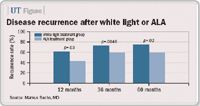Article
Fluorescence cysto reduces bladder cancer recurrence
Berlin--5-aminolevulinic acid (ALA) was introduced about 10 years ago as a means of identifying tumor tissue in the bladder by causing it to fluoresce under the appropriate light. The question that the technology raised was whether the new lighting system under which the tumors and suspicious lesions were removed led to a reduction in the progression and recurrence of bladder tumors.

A number of small, uncontrolled studies suggested that it did so. Now German researchers have provided a more definitive answer. Markus Sachs, MD, a urologist at the Charité Universitätsmedizin Berlin presented a crowded symposium at the AUA annual meeting with data derived from a 5-year prospective randomized trial comparing ALA to standard white light illumination in 115 patients undergoing resection for suspected superficial bladder cancer.
At 1 year, 3 years, and 5 years, the recurrence rate was significantly lower in the group undergoing examination and resection by ALA than that of patients undergoing the same procedure under white light.

"Our department's policy now is to use ALA fluorescence cystoscopy and transurethral resection in every patient who arrives with an initial diagnosis of bladder cancer," Dr. Sachs explained.
"We then follow these patients with white light cystoscopy. We found that after the patients have been treated or after they have received intravesical therapy, there was too much red light showing up in cystoscopy. There were too many false positives. So we follow these patients with white light."
To arrive at these conclusions, Dr. Sachs and his team randomized 115 patients with suspected superficial bladder cancer to undergo examination and resection under white light or violet-blue light following instillation of 3% ALA solution, 50 mL. A second look, including TUR, was conducted at 6 to 8 weeks.
The primary endpoints of the study were recurrence rates detected at 12, 36, and 60 months. Recurrence rates for patients undergoing white light examination were 61% at 3 months, 73% at 36 months, and 75% at 60 months. The recurrence rates for patients undergoing ALA examination were 43% at 3 months, 59% at 36 months and 59% at 60 months. The median time to first recurrence was 5 months in the white light cohort and 12 months in the ALA cohort. All findings achieved statistical significance.
Dr. Sachs noted that an earlier German study followed white light and ALA patients over 48 months to find that the recurrence-free rate in the white light group was 60.7% compared with 85% in the ALA group (Urologe A 2003; 42:1366-73). He said a number of these patients were given intravesical therapy, which may have skewed the results more favorably toward ALA.
Turning again to his study, Dr. Sachs said cost analysis showed ALA to have a strong economic advantage because it reduced the number of resections from 1.3 per year to 0.94 per year.
Newsletter
Stay current with the latest urology news and practice-changing insights — sign up now for the essential updates every urologist needs.















